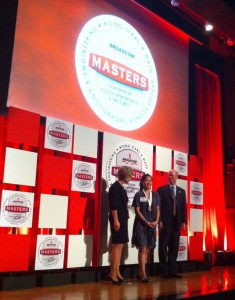WASHINGTON — The typical middle school trip to Washington involves visits to Capitol Hill and a few museums. But for 14-year-old I-Chun Lin of Plano, Texas, her trip to the nation’s capital this week came with a $5,000 award and national recognition for her science project on solar cell efficiency.

Photo by Sara J. Martinez/MNS. I-Chun Lin, 14, accepts her 3rd place award with the Elizabeth Marincola, president of the Society for Science and the Public, and Scott McGregor, CEO/President of Broadcom.
On Tuesday, the Society for Science & the Public announced the winners of the inaugural Broadcom “Math, Applied Science, Technology and Engineering for Rising Stars” competition out of 30 finalists from middle school science fairs around the country.
“I’ve been doing science fairs since I was in kindergarten, and I’ve always really loved doing a project on something I have an interest in,” said Lin, who won third place overall. “I have never competed at this level. It has been amazing.”
Lin traveled to Washington with three other students from Texas: Ria Chhabra, 14, and Alicia D’Souza, 13, both of Plano, and Lauren Hall, 13, of Corpus Christi.
“These Broadcom MASTERS demonstrate the potential of our youth to succeed,” said Elizabeth Marincola, president of SSP. “They exemplify what people of any age can do, if given the right encouragement, direction and support.”
The finalists were treated to tours of historic sites and organizations that celebrate science, technology, engineering and mathematics, according to Broadcom Corp. spokeswoman Jennifer Baumgartner. On Tuesday, they visited the White House to meet John Holdren, the president’s adviser for science and technology, along with other officials from the Office of Science and Technology Policy, before the evening’s award ceremony.
“The sky is no longer the limit because there are footsteps on the moon,” said Chhabra, whose peers elected her to be class speaker. “Why are there footsteps on the moon? Well I have an answer for that question, and that is science, technology and engineering.”
Each of the 30 finalists will receive a $1,000 donation to their school. Students and their teachers each will have an asteroid named after them through the Ceres Connection program, which names minor planets discovered the Lincoln Near-Earth Asteroid Research Program.
The top award and $25,000 went to 15-year-old Daniel Feeny of Woodside, Calif., for his project on wave forces in the intertidal zone on a beach in California.
This was the first year of the middle school competition, but the Texas finalists are already planning for next year.
“I’m probably going to do a project on hydrogen splitting, which is a different kind of green energy,” Lin said.
It would be her third year exploring green energy in science fair projects, and her goal is to apply her scientific knowledge to a career in medicine or engineering.
“Ultimately, I just want to come up with something that will help improve people’s lives,” she said.
